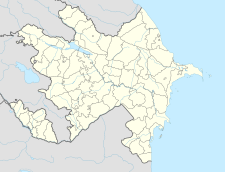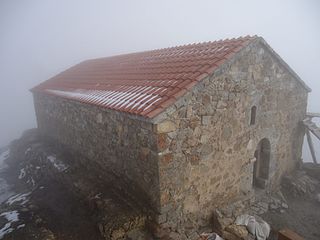Katarovank
| Katarovank | ||
|---|---|---|
Կատարովանք | ||
Year consecrated before 335 AD | | |
| Location | ||
| Location | near the village of Hin Tagher, Khojavend | |
| Country | Azerbaijan | |
| Geographic coordinates | 39°31′34″N 46°51′22″E / 39.526071°N 46.856119°E | |
| Architecture | ||
| Architect(s) | yes | |
| Type | Monastery, Church | |
| Style | Armenian | |
| Completed | 4th century, 17th century | |
| Materials | sandstone | |
Katarovank (Armenian: Կատարովանք; Azerbaijani: Qatərəvəng) is an Armenian Apostolic monastery in the Khojavend District of Azerbaijan. It is located close to the village of Hin Tagher (Köhnə Tağlar). The monastery was founded in the 4th century, but the present structure was completed in the 17th century.
History and architecture
This section needs additional citations for verification. (January 2021) |
The 5th-century Armenian historian
Suspicious of St. Grigoris, Sanesan ordered to execute the saint on the plain of Vatnean by tying him to a wild horse. His children fled the royal palace together with St. Grigoris' missionaries who carried with them St. Grigoris' body. The children decided to hide in the mountaintop Katarovank Monastery, which at the time hosted as many as 3870 hermits and pilgrims.[3] But Sanesan in his pursuit of the children reached the monastery and killed all the inhabitants of Katarovank, including his own children. The monastery was destroyed by the Hun soldiers and the corpses of the killed were burned.[citation needed]
The present-day chapel is a 17th-century structure. It is a single nave basilica constructed from the blocks of local coarse-cut sandstone. One side of the chapel is below the ground while the other is built on bare rock. There are Armenian
2020 Nagorno-Karabakh war
Gallery
-
Katarovank
-
Katarovank
-
Scenery around Katarovank
Books
- The Epic Histories: Attributed to P'awstos Buzand. Columbia University Press, Department of Near Eastern Languages and Civilizations, 1989
- Movses Kalankatuatsi. History of the Land of Aluank, translated from Old Armenian by Sh. V. Smbatian. Yerevan: Matenadaran (Institute of Ancient Manuscripts), 1984, Book I, chapter 14, in Russian.
- (in Italian) Documenti di architettura armena, Alexandr L. Jakobson – 1986 – 73 p.
References
- ^ The Epic Histories: Attributed to P'awstos Buzand. Columbia University Press, Department of Near Eastern Languages and Civilizations, 1989
- ISBN 978-9952-34-156-0.
- ^ a b Mkrtchian, Shahen. Historical and Architectural Monuments of Nagorno Karabakh. Yerevan: Hayastan Publishing House, 1988, p. 100
- ^ CIVILNET - A Piece of Hadrut Remains Armenian
- ^ President Sarkissian Says Government Has Not ‘Provided Satisfactory Explanation’ About Attacks on Hadrut
- ^ Azerbaijan Says Four Soldiers Killed Amid Cease-Fire Violations In Nagorno-Karabakh
- ^ "Армения и Азербайджан развязали войну трактовок". kommersant.ru (in Russian). Kommersant. 16 December 2020. Retrieved 21 December 2020.
- ^ "Hadrutun iki kəndi yenidən Azərbaycanın nəzarətindədir". bbc.com/azeri (in Azerbaijani). BBC Azeri service. 13 December 2020. Retrieved 21 December 2020.









